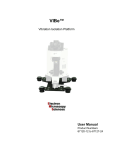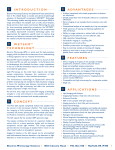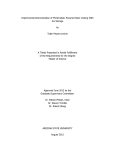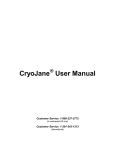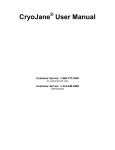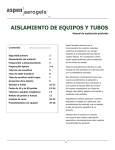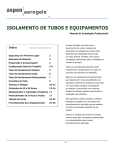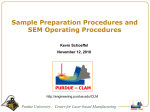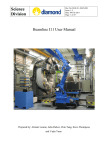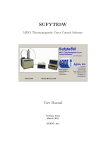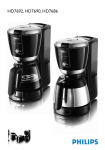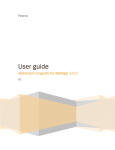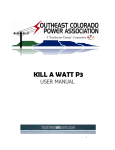Download Gentle Jane Snap Freezer
Transcript
® Stand-Alone Gentle Jane User Manual CAT. 62380-10 Customer Service 1-800-523-5874 (in continental US only) Customer Service 1-215-412-8400 (International) Online: www.emsdiasum.com E-mail: [email protected] 1 Introduction to Freezing In the conventional freezing method the tissue is typically frozen at about -30°C on the cryostat freeze-bar. During this relatively slow freezing process the ice crystals that form are usually large compared to cellular dimensions. These crystals can cause considerable displacement and structural damage to the tissue. The extent of such displacement and damage is largely masked when the sections are melted to mount them on glass slides, and is therefore not generally appreciated. Snap-Freezing tissue is the best way to insure the smallest ice crystal size and will result in minimal damage to the tissue. Liquid nitrogen, with a freezing temperature of -196°C, is highly recommended for use with the Gentle Jane method. It is safe, non-flammable, non-explosive and non-ozone depleting. Other low temperature refrigerants can also be employed. Stand-Alone Gentle Jane® (SAGJ) Parts Gentle Jane Device SAGJ Foam Insulation 1. SAGJ Outer Metal Jacket (Fig. 1) 2. SAGJ Foam Insulation (Fig. 1) 3. SAGJ Inner Chamber (Fig. 1) 4. Gentle Jane Device (Fig. 1) 5. Heat Extractor (Figs. 2,4) 6. Plastic Thermos (Fig. 2) 7. Blockholders (Figs. 3,4) SAGJ Outer SAGJ Inner Metal Jacket Chamber Fig. 1: Parts of the Stand Alone Gentle Jane 2 Preparation Heat Extractor Fill the plastic thermos with LN2 and pour into the bottom of the SAGJ chamber. Refill the thermos with LN2. Place the Heat Extractor in the thermos. The LN2 will boil off very rapidly as the extractor is cooling down. Refill the thermos when the LN2 boils away (in about 1 minute). If necessary, fill a third time. At least ½ of the Heat Extractor should be immersed in LN2 when the LN2 begins to “simmer.” Plastic Thermos Fig. 2: SAGJ Plastic Thermos and Heat Extractor Note: Just before the Heat Extractor equilibrates at the LN2 temperature (-196°C), the LN2 will boil very rapidly. Shortly thereafter (within 10 seconds) the boiling will abruptly diminish to a “simmer”. During the cool-down period the cold nitrogen gas cools the interior of the freezing chamber. As long as there is LN2 in the small thermos the temperature inside the chamber will be maintained at -20 to -25°C. After depletion of the LN2, the temperature will rise. After about two hours, additional LN2 should be poured into the chamber if you wish to maintain the low temperature. Use In general, it is recommended that a base layer of embedding medium be frozen on the Blockholder (specimen holder) to prevent tissue from freezing into the waffle pattern on the face of the Blockholder. To prepare a base layer, dispense room temperature CryoGel (or other embedding medium) onto a room temperature Blockholder. Place the block on the square post of the Gentle Jane device. Cryo-Gel Block holder Fig. 3: Dispensing Cryo-Gel onto Blockholder 3 Remove the Heat Extractor from the LN2 and insert it into its horseshoeshaped holder directly above the Blockholder. Release the Heat Extractor. The medium will freeze in 810 seconds. Once frozen, place the Heat Extractor back into the plastic thermos and remove the block from the post. Dispense additional embedding medium onto the base layer. Position the tissue on top of the embedding medium. Place the Blockholder again on the square post of the Gentle Jane device. Reinsert the Heat Extractor and release. The Heat Extractor will drop at a controlled velocity. When it contacts the tissue it will slightly flatten and simultaneously snap-freeze both the tissue and the surrounding embedding medium. Remove the Heat Extractor after 8 to 10 seconds or when the “frost line” reaches the top of the Heat Extractor. Failure to remove the Heat Extractor within 20 seconds can result in a block that is too cold and brittle to section immediately. Heat Extractor Blockholde r Fig. 4: Snap-Freezing with the Heat Extractor on the Gentle Jane Device. NOTE: If an appropriate amount of Cryo-Gel (or other embedding medium) is dispensed onto the Blockholder you should have a circular disc of frozen medium that just covers the Blockholder surface. The diameter of the disc should be approximately ¾ inch. The thickness of this layer will depend on the thickness of the piece of tissue to be frozen. Freezing times will vary. Rigid specimens, such as bone, do not flatten at all and may require up to 20 seconds to completely freeze, especially for specimens thicker than 3mm. Any embedding medium that runs over the side of the Blockholder and freezes should be cut away or it may not be possible to clamp the Blockholder properly in the microtome chuck. Cryo-Gel is recommended because it‘s very viscous and when dispensed properly will not flow over the sides of the Blockholder. To section the specimen, transfer the frozen tissue block rapidly to the cryostat to avoid any thawing of the tissue. 4 Daily Maintenance When moisture condenses on any of the Gentle Jane’s moving parts it is highly probable that the device will freeze-up when it is cooled below 0°C. If this happens, the Heat Extractor will not drop when released. The Heat Extractor should never be forced down since that could damage the internal control mechanism. To correct this condition it is first necessary to melt the ice and then drive off the water. This can best be done with a hot air blow dryer directed on the Gentle Jane for at least 5 minutes to insure that all parts will be free of any moisture. Or the Gentle Jane device can be removed and placed in a 37ºC oven for 1 hour. Once fully dry, the Gentle Jane device can be cooled and used as described previously. DO NOT USE ANY LUBRICANTS ON THE GENTLE JANE DEVICE! To prevent the Gentle Jane from freezing-up, observe the following: 1. Keep the lid on the Gentle Jane chamber to prevent warm, moist air from entering and condensing on the chamber walls and Gentle Jane device during the interval between specimens. 2. If you expect to be freezing tissue, it is recommended that LN2 be added to the plastic thermos every 2 to 3 hours. This will chill the chamber and drive off any warm, moist air. 3. At the end of the day, remove the lid to permit any moisture in the chamber or on the Gentle Jane device to evaporate overnight. 5 SNAP-FREEZING STEP-BY-STEP Step 1: COOL THE HEAT EXTRACTOR A Heat Extractor is chilled to -196°C in a plastic thermos containing Liquid Nitrogen. Step 2: FORM A BASE LAYER A small amount of Cryo-Gel or other mounting media is dispensed onto a Blockholder. The Heat Extractor is placed on the Gentle Jane device and falls at a controlled rate forming a frozen base layer in 8 -10 seconds. Step 3: ORIENT THE SPECIMEN Additional Cryo-Gel or other mounting media is dispensed onto the base layer. The specimen is oriented on the mounting media. Step 4: FREEZE THE SPECIMEN The Heat Extractor is once again placed on the Gentle Jane device. The specimen and mounting medium are snap-frozen in 8 -10 seconds. The Heat Extractor is returned to the plastic thermos. The specimen is now ready to be sectioned. 6 7







